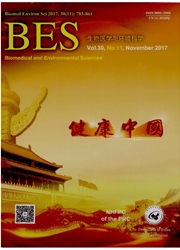

 中文摘要:
中文摘要:
在那里的目的几乎不是上的很少知识煽动性的 biomarkers 正在聚类例如 C 反应的蛋白质(CRP ) ,可溶的细胞内部的粘附 molecule1-1 (sICAM-1 ) ,和血管收缩素 II (Ang II ) ,在有在蒙古的人口的高血压的个人。在现在的学习,我们在中国在一张蒙古的人口调查了这种关系。2589 成年 Mongolians 全部的方法 A, 20 岁以上,作为学习参加者被招募。人口分布,生活方式,高血压的家庭历史,血压,和血化学上的数据被收集,并且煽动性的 biomarkers 在所有参加者被测量。结果有二或三 biomarkers 的增加的层次的题目的比例在有高血压的那些是显著地更高的(21.0% 和 6.0% ,分别地) 比在那些与 prehypertension (12.7% 和 0.5% ,分别地) 或 normotension (8.1% 和 0.2% ,分别地) 。高血压的调整机会比率(95% 信心间隔) 与一,二或三 biomarkers 的增加的层次联系了的 multivariate 是 0.94 (0.721.22 ) , 1.42 (0.932.16 ) ,并且 11.08 (1.4584.80 ) ,分别地与没有任何 biomarker 的增加的题目相比。结论高血压在蒙古的人口与煽动性的 biomarkers 的簇被联系。
 英文摘要:
英文摘要:
Abstract Objective There is little knowledge on whether there is clustering of inflammatory biomarkers, such as C-reactive protein (CRP), soluble intracellular adhesion molecule1-1 (slCAM-1), and angiotensin It (Ang Ⅱ), in individuals with hypertension in the Mongolian population. In the present study, we investigated this relationship in a Mongolian population in China. Methods A total of 2589 adult Mongolians, aged 20 years and older, were recruited as study participants. Data on demographics, lifestyle, family history of hypertension, blood pressure, and blood chemistry were collected, and inflammatory biomarkers were measured in all participants. Results The proportion of subjects with increased levels of two or three biomarkers was significantly higher in those with hypertension (21.0% and 6.0%, respectively) than in those with prehypertension (12.7% and 0.5%, respectively) or normotension (8.1% and 0.2%, respectively). The multivariate adjusted odds ratios (95% confidence interval) of hypertension associated with increased levels of one, two or three biomarkers were 0.94 (0.72-1.22), 1.42 (0.93-2.16), and 11.08 (1.45-84.80), respectively, compared with subjects with no increase in any biomarker. Conclusion Hypertension was associated with a cluster of inflammatory biomarkers in the Mongolian population.
 同期刊论文项目
同期刊论文项目
 同项目期刊论文
同项目期刊论文
 The interactive effect of diabetes and central obesity on stroke: a prospective cohort study of inne
The interactive effect of diabetes and central obesity on stroke: a prospective cohort study of inne Effects of Immediate Blood Pressure Reduction on Death and Major Disability in Patients With Acute I
Effects of Immediate Blood Pressure Reduction on Death and Major Disability in Patients With Acute I Association of hypertension with coexistence of abnormal metabolism and inflammation and endothelial
Association of hypertension with coexistence of abnormal metabolism and inflammation and endothelial Hypertension, alcohol drinking and stroke incidence: a population-based prospective cohort study amo
Hypertension, alcohol drinking and stroke incidence: a population-based prospective cohort study amo Utility of Framingham general cardiovascular disease risk score for predicting 10-year cardiovascula
Utility of Framingham general cardiovascular disease risk score for predicting 10-year cardiovascula Comparison of lipid accumulation product with body mass index as an indicator of hypertension risk a
Comparison of lipid accumulation product with body mass index as an indicator of hypertension risk a Association of Biomarkers of Inflammation with Dyslipidemia and Its Components among Mongolians in C
Association of Biomarkers of Inflammation with Dyslipidemia and Its Components among Mongolians in C Smoking, Heart Rate, and Ischemic Stroke A Population-Based Prospective Cohort Study Among Inner Mon
Smoking, Heart Rate, and Ischemic Stroke A Population-Based Prospective Cohort Study Among Inner Mon Hypertension and elevated C-reactive protein: Future risk of ischemic stroke in a prospective cohort
Hypertension and elevated C-reactive protein: Future risk of ischemic stroke in a prospective cohort Hypertension subtypes and risk of cardiovascular diseases in a Mongolian population, Inner Mongolia,
Hypertension subtypes and risk of cardiovascular diseases in a Mongolian population, Inner Mongolia, Combinedeffects of hypertension and heart rate on the risk of stroke and coronary heartdisease: a po
Combinedeffects of hypertension and heart rate on the risk of stroke and coronary heartdisease: a po Association of obesity and biomarkers of inflammation and endothelial dysfunction in adults in Inner
Association of obesity and biomarkers of inflammation and endothelial dysfunction in adults in Inner Association of elevated inflammatory and endothelial biomarkers with prehypertension among Mongolian
Association of elevated inflammatory and endothelial biomarkers with prehypertension among Mongolian Biomarkers of inflammation, endothelial dysfunction and insulin resistance in adults of Inner Mongol
Biomarkers of inflammation, endothelial dysfunction and insulin resistance in adults of Inner Mongol Relationship between white blood cell count at admission and short term outcome in patients with acu
Relationship between white blood cell count at admission and short term outcome in patients with acu Biomarkers of inflammation and endothelial dysfunction and risk of hypertension among Inner Mongolia
Biomarkers of inflammation and endothelial dysfunction and risk of hypertension among Inner Mongolia 期刊信息
期刊信息
